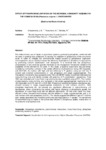Please use this identifier to cite or link to this item:
http://www.alice.cnptia.embrapa.br/alice/handle/doc/1036664Full metadata record
| DC Field | Value | Language |
|---|---|---|
| dc.contributor.author | CHIARAMONTE, J. B. | pt_BR |
| dc.contributor.author | ROSSMANN, M. | pt_BR |
| dc.contributor.author | MENDES, R. | pt_BR |
| dc.date.accessioned | 2016-02-11T11:11:11Z | pt_BR |
| dc.date.available | 2016-02-11T11:11:11Z | pt_BR |
| dc.date.created | 2016-02-11 | pt_BR |
| dc.date.issued | 2015 | pt_BR |
| dc.identifier.citation | In: CONGRESSO BRASILEIRO DE MICROBIOLOGIA, 28., Florianópolis. Anais... Florianópolis: Sociedade Brasileira de Microbiologia, 2015. Ref. 1125-1. | pt_BR |
| dc.identifier.uri | http://www.alice.cnptia.embrapa.br/alice/handle/doc/1036664 | pt_BR |
| dc.description | Abstract: The indiscriminate use of inputs in agricultural systems, particularly phosphate, combined with the need of growing food production, is causing the depletion of phosphorus mines around the world. In order to mitigate the environmental impact caused by phosphorus exploration microorganisms can be used to increase the efficiency of phosphorus utilization in crop systems by promoting nutrient solubilization and absorption. It is believed that low phosphorus concentration in soil, enriches specific members of the rhizosphere microbiome related to the availability of this element to the plant. In this study, a factorial experiment was performed considering contrasting cultivars in the uptake efficiency of phosphorus (being IAC-Imperador and DOR-364, the cultivar with high and low efficiency in P uptake); using soil with low P content and enriched concentrations of rock phosphate and single superphosphate. The rhizosphere microbiome was accessed using TSA and NBRIP media, to estimate total bacterial colony-forming units and identify isolates with potential of P solubilization, respectively. Total DNA was extracted and mycorrhizal fungi community was quantified using qPCR. The number of total bacteria colony-forming unit increased in the single superphosphate treatments of the IAC-Imperador (p<0.01), but not in DOR-364. Phosphorus solubilizing bacteria abundance also showed increase in single superphosphate treatments in both cultivars (p<0.01). Rock phosphate treatments did not showed any significant differences in colony-forming unit abundances. When considering the cultivar with higher efficiency in phosphorus uptake, the abundance of mycorrhizal fungi did not differed significantly. On the other hand, the lower efficient cultivar showed 5-fold increase with the addition of single superphosphate, and a 10-fold increase with rock phosphate (p<0.01). The results suggest that different type of P and the plant variety assembles the microbial community that helps plants in P uptake. The recruitment of mycorrhizal fungi is higher in the cultivar less efficient in phosphorus uptake, mainly when in the presence of phosphate rock. | pt_BR |
| dc.language.iso | eng | eng |
| dc.rights | openAccess | eng |
| dc.subject | P uptake | pt_BR |
| dc.subject | Rhizosphere microbiome | pt_BR |
| dc.subject | Plant-microbe interactions | pt_BR |
| dc.subject | Phosphate solubilizing bacteria | pt_BR |
| dc.title | Effect of phosphorus limitation on the microbial community assembly in the common bean (Phaseolus vulgaris L.) rhizosphere. | pt_BR |
| dc.type | Resumo em anais e proceedings | pt_BR |
| dc.date.updated | 2016-02-12T11:11:11Z | pt_BR |
| dc.subject.thesagro | Phaseolus Vulgaris | pt_BR |
| dc.subject.nalthesaurus | mycorrhizal fungi | pt_BR |
| riaa.ainfo.id | 1036664 | pt_BR |
| riaa.ainfo.lastupdate | 2016-02-12 | pt_BR |
| dc.contributor.institution | J. B. CHIARAMONTE, ESALQ/USP; M. ROSSMANN; RODRIGO MENDES, CNPMA. | pt_BR |
| Appears in Collections: | Resumo em anais de congresso (CNPMA)  | |
Files in This Item:
| File | Description | Size | Format | |
|---|---|---|---|---|
| 2015RA072.pdf | 59.9 kB | Adobe PDF |  View/Open |









